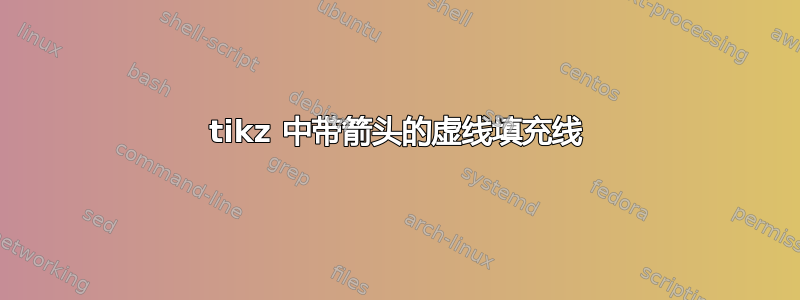
如何在以下箭头样式中获得箭头周围的虚线?
\documentclass{article}
\usepackage{tikz}
\usetikzlibrary{positioning,arrows.meta}
\begin{document}
\tikzstyle{dotArrow} = [
draw=blue, dotted, line width=0.6pt, double distance=4pt,
{Bar[width=5.2pt]}-{Triangle[angle=90:7.2pt, fill=white]},
postaction={draw=white, solid, line width=4pt, shorten >=4pt, shorten <=0.6pt, -}]
\begin{tikzpicture}[outer sep=5pt]
\node[draw] (node1) {Node 1};
\node[draw, right=of node1] (node2) {Node 2};
\draw[dotArrow] (node1) -- (node2);
\end{tikzpicture}
\end{document}
答案1
在arrows.meta库中,虚线图案通过命令关闭\pgfsetdash{}{+0pt}。您可以做的是复制样式、更改名称和修改虚线图案。
\documentclass{article}
\usepackage{tikz}
\usetikzlibrary{positioning,arrows.meta}
\makeatletter
\pgfdeclarearrow{
name = Dashed Stealth,
defaults = {
length = +3pt 4.5 .8,
width' = +0pt .75,
inset' = +0pt 0.325,
line width = +0pt 1 1,
},
setup code = {
% Cap the line width at 1/4th distance from inset to tip
\pgf@x\pgfarrowlength
\advance\pgf@x by-\pgfarrowinset
\[email protected]\pgf@x
\ifdim\pgf@x<\pgfarrowlinewidth
\pgfarrowlinewidth\pgf@x
\fi
% Compute front miter length:
\pgfmathdivide@{\pgf@sys@tonumber\pgfarrowlength}{\pgf@sys@tonumber\pgfarrowwidth}%
\let\pgf@temp@quot\pgfmathresult%
\pgf@x\pgfmathresult pt%
\pgf@x\pgfmathresult\pgf@x%
\pgf@x4\pgf@x%
\advance\pgf@x by1pt%
\pgfmathsqrt@{\pgf@sys@tonumber\pgf@x}%
\pgf@xc\pgfmathresult\pgfarrowlinewidth% xc is front miter
\[email protected]\pgf@xc
\pgf@xa\pgf@temp@quot\pgfarrowlinewidth% xa is extra harpoon miter
% Compute back miter length:
\[email protected]\pgfarrowwidth%
\csname pgfmathatan2@\endcsname{\pgfmath@tonumber\pgfarrowlength}{\pgfmath@tonumber\pgf@ya}%
\pgf@yb\pgfmathresult pt%
\csname pgfmathatan2@\endcsname{\pgfmath@tonumber\pgfarrowinset}{\pgfmath@tonumber\pgf@ya}%
\pgf@ya\pgfmathresult pt%
\advance\pgf@yb by-\pgf@ya%
\[email protected]\pgf@yb% half angle in yb
\pgfmathtan@{\pgf@sys@tonumber\pgf@yb}%
\pgfmathreciprocal@{\pgfmathresult}%
\pgf@yc\pgfmathresult\pgfarrowlinewidth%
\[email protected]\pgf@yc%
\advance\pgf@ya by\pgf@yb%
\pgfmathsincos@{\pgf@sys@tonumber\pgf@ya}%
\pgf@ya\pgfmathresulty\pgf@yc% ya is the back miter
\pgf@yb\pgfmathresultx\pgf@yc% yb is the top miter
\ifdim\pgfarrowinset=0pt%
\[email protected]\pgfarrowlinewidth% easy: back miter is half linewidth
\fi
% Compute inset miter length:
\pgfmathdivide@{\pgf@sys@tonumber\pgfarrowinset}{\pgf@sys@tonumber\pgfarrowwidth}%
\let\pgf@temp@quot\pgfmathresult%
\pgf@x\pgfmathresult pt%
\pgf@x\pgfmathresult\pgf@x%
\pgf@x4\pgf@x%
\advance\pgf@x by1pt%
\pgfmathsqrt@{\pgf@sys@tonumber\pgf@x}%
\pgf@yc\pgfmathresult\pgfarrowlinewidth% yc is inset miter
\[email protected]\pgf@yc%
% Inner length (pgfutil@tempdima) is now arrowlength - front miter - back miter
\pgfutil@tempdima\pgfarrowlength%
\advance\pgfutil@tempdima by-\pgf@xc%
\advance\pgfutil@tempdima by-\pgf@ya%
\[email protected]\pgfarrowwidth%
\advance\pgfutil@tempdimb by-\pgf@yb%
% harpoon miter correction
\ifpgfarrowroundjoin
\pgfarrowssetbackend{\pgf@ya\advance\pgf@x by-.5\pgfarrowlinewidth}
\else
\pgfarrowssetbackend{0pt}
\fi
\ifpgfarrowharpoon
\pgfarrowssetlineend{\pgfarrowinset\advance\pgf@x
by\pgf@yc\advance\pgf@x by.5\pgfarrowlinewidth}
\else
\pgfarrowssetlineend{\pgfarrowinset\advance\pgf@x by\pgf@yc\advance\pgf@x by-.25\pgfarrowlinewidth}
\ifpgfarrowreversed
\ifdim\pgfinnerlinewidth>0pt
\pgfarrowssetlineend{\pgfarrowinset}
\else
\pgfarrowssetlineend{\pgfutil@tempdima\advance\pgf@x by\pgf@ya\advance\pgf@x by-.25\pgfarrowlinewidth}
\fi
\fi
\fi
\ifpgfarrowroundjoin
\pgfarrowssettipend{\pgfutil@tempdima\advance\pgf@x by\pgf@ya\advance\pgf@x by.5\pgfarrowlinewidth}
\else
\pgfarrowssettipend{\pgfarrowlength\ifpgfarrowharpoon\advance\pgf@x by\pgf@xa\fi}
\fi
% The hull:
\pgfarrowshullpoint{\pgfarrowlength\ifpgfarrowroundjoin\else\ifpgfarrowharpoon\advance\pgf@x by\pgf@xa\fi\fi}{\ifpgfarrowharpoon-.5\pgfarrowlinewidth\else0pt\fi}%
\pgfarrowsupperhullpoint{0pt}{.5\pgfarrowwidth}%
\pgfarrowshullpoint{\pgfarrowinset}{\ifpgfarrowharpoon-.5\pgfarrowlinewidth\else 0pt\fi}%
% Adjust inset
\pgfarrowssetvisualbackend{\pgfarrowinset}
\advance\pgfarrowinset by\pgf@yc%
% The following are needed in the code:
\pgfarrowssavethe\pgfutil@tempdima
\pgfarrowssavethe\pgfutil@tempdimb
\pgfarrowssavethe\pgfarrowlinewidth
\pgfarrowssavethe\pgf@ya
\pgfarrowssavethe\pgfarrowinset
},
drawing code = {
\pgfsetdash{{1pt}{1pt}}{0pt}
\ifpgfarrowroundjoin\pgfsetroundjoin\else\pgfsetmiterjoin\fi
\ifdim\pgfarrowlinewidth=\pgflinewidth\else\pgfsetlinewidth{+\pgfarrowlinewidth}\fi
\pgfpathmoveto{\pgfqpoint{\pgfutil@tempdima\advance\pgf@x by\pgf@ya}{0pt}}
\pgfpathlineto{\pgfqpoint{\pgf@ya}{\pgfutil@tempdimb}}
\pgfpathlineto{\pgfqpoint{\pgfarrowinset}{0pt}}
\ifpgfarrowharpoon \else
\pgfpathlineto{\pgfqpoint{\pgf@ya}{-\pgfutil@tempdimb}}
\fi
\pgfpathclose
\ifpgfarrowopen\pgfusepathqstroke\else\ifdim\pgfarrowlinewidth>0pt\pgfusepathqfillstroke\else\pgfusepathqfill\fi\fi
},
parameters = {
\the\pgfarrowlinewidth,%
\the\pgfarrowlength,%
\the\pgfarrowwidth,%
\the\pgfarrowinset,%
\ifpgfarrowharpoon h\fi%
\ifpgfarrowopen o\fi%
\ifpgfarrowroundjoin j\fi%
},
}
\makeatother
\pgfkeys{
Dashed Triangle /.tip = {Dashed Stealth[inset=+0pt, angle=+60:+2.7pt +3.6]},
}
\begin{document}
\tikzset{dotArrow/.style={
draw=blue, dotted, line width=0.6pt, double distance=4pt,
{Bar[width=5.2pt]}-{Dashed Triangle[angle=90:7.2pt, fill=white]},
postaction={draw=white, solid, line width=4pt, shorten >=4pt, shorten <=0.6pt, -}}
}
\begin{tikzpicture}[outer sep=5pt]
\node[draw] (node1) {Node 1};
\node[draw, right=of node1] (node2) {Node 2};
\draw[dotArrow] (node1) -- (node2);
\end{tikzpicture}
\end{document}
答案2
不确定我是否正确理解了这个问题,我希望以下内容有所帮助。
\documentclass{article}
\usepackage{tikz}
\usetikzlibrary{positioning,arrows.meta}
\usetikzlibrary{shapes.arrows}
\begin{document}
\tikzstyle{dotArrow} = [
draw=draw, blue, dotted, single arrow,
minimum height=10mm, minimum width=5mm,
single arrow head extend=2mm]
\begin{tikzpicture}[outer sep=5pt]
\node[draw] (node1) {Node 1};
\node[draw, right=of node1] (node2) {Node 2};
\node[dotArrow] at (1.3, 0);
\end{tikzpicture}
\end{document}





